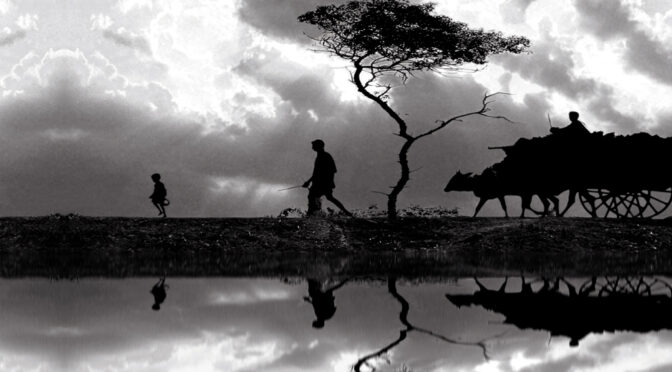By Shrii Prabhat Rainjan Sarkar
The following is the 31st and last chapter of Shrii Sarkar's book Ráŕh: The Cradle of Civilization, Ananda Marga Publications.
This world of ours is made up of good and bad. And the good and the bad things are done not so much by nature as by human beings. The good things that humans have the capacity for are friendliness, intimacy, love, sweet amiability – both internal and external – sitting together to eat and to talk, trying to feel the joys and sorrows of others, and so on. And of the bad things that humans do, the first and foremost is the exploitation of one human by another. This exploitation occurs sometimes in the religious sphere, sometimes in the social sphere, sometimes in the mental sphere and sometimes in the economic sphere.
When human beings first appeared on earth, that was the Shúdra Age. Ráŕh was no exception. When the people of that age all began to feel that they should live collectively in order to fight against the obstacles and dangers of their adverse environment, they began to search for a chieftain. At the initial stage, a woman used to be the chieftain. Even though she may not have had to do anything, she served as a symbol of group-oriented living – just like a queen ant or a queen bee or a queen white ant. In this way there emerged the ancient matriarchal society. When, later on, it made way for the patriarchal society – when it became evident that a patriarchal society [patrilineal order] was necessary for determining the lineage of the children – males began to assume the roles of chieftains. These chieftains used to be called, in more polished language, rájás [kings]. Ráŕh too saw the emergence of patriarchal society. But it was slightly different than in other parts of the world. In most countries, where the society was matriarchal, the matrilineal order of lineage prevailed, and where the society was patriarchal, the patrilineal order prevailed. Though Ráŕhʼs present social system is patriarchal, the systems of lineage and right to perform the last rites, and, in some cases, inheritance, are not completely patrilineal. What is found is a beautiful mixture of the patrilineal and matrilineal orders.
The male-dominated society is followed by the Kśatriya Age. At the initial stage there is only the kśatriyasʼ shásan [control and administration], but later comes shośań [exploitation] as well. During the Kśatriya Age, if the populace can flatter their king, they can pass their days happily. But when the Vaeshya Age eventually follows, peopleʼs very existence becomes unbearable. The Kśatriya Age lasted for a long time in Ráŕh. But soon after the fall of local kingdoms, the Vaeshya Age with all its ruthlessness tightened its noose around the people of Ráŕh. There being no way out, the hapless people of Ráŕh, like the people of other countries in the world, gave in to the exploitation of the Vaeshya Age.
The exploitation in Ráŕh was very extreme, and it still is. The vaeshya control and administration and vaeshya exploitation in Ráŕh manifests itself in two different ways: 1) exploitation by the local vaeshyas, which is relatively insignificant, and 2) exploitation by the outsider vaeshyas, which is very extreme. The fundamental difference between the exploitation by the local vaeshyas and that by the outsiders is this: though both are exploiters and the exploitation of both causes people to cry aloud for relief, the local exploiters mostly keep their exploitation-gotten wealth within the territory of the land, and hence there is a chance for that wealth to be utilized in future in the service of the people. But the outsider exploiters will in most cases transfer outside all the wealth that they have ruthlessly squeezed out of the land. This means that there is no chance whatsoever for those resources to be utilized in future in the service of the local people.
Today a heavy load of exploitation is breaking the backs of the people of Ráŕh. To save Ráŕh without delay, an all-round socio-economic rehabilitation plan is needed. Ráŕh is filled with natureʼs inexhaustible store, and yet the people of Ráŕh are not able to eat their fill of nutritious food. What a heart-rending sight! It may not be possible for the present inhabitants of Ráŕh alone to do all that is necessary to save their land from this miserable plight. So those from outside Ráŕh must also come forward to help Ráŕh, otherwise a highly-civilized and cultured human population will be ruined.
Nature has blessed Ráŕh bountifully with underground resources, above-ground resources, water resources, and everything else. It is up to human beings to arrange for the rational utilization and humane distribution of those gifts.
Ráŕh appears emaciated from starvation, miserably struck by misfortune, and chained with slumber because of the lack of proper consciousness regarding the need of the hour. Let all rational persons of the world think collectively about Ráŕhʼs distress, and let them come forward with their help to build up Ráŕh.
Ráŕh is the starting-point of human civilization, Ráŕh is the hub of human culture. Let that Ráŕh shine again in its own glory. Let that Ráŕh again brim over with fruits, flowers, treasures, humanity and spirituality. Let the shroud of mist obscuring Ráŕhʼs path of progress blow away, let Ráŕhʼs melancholy face brighten with a smile. With these good wishes, let me conclude.
Nacer Tale Egiye Cale – (Prabhat Sangiit #11)
All rights reserved. Published with permission by Ananda Marga Publications

